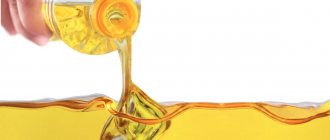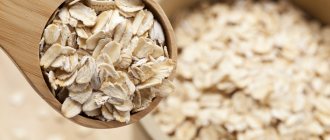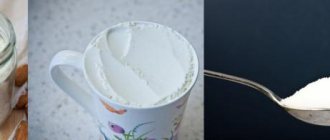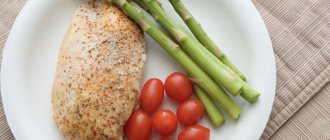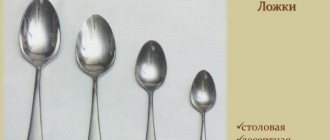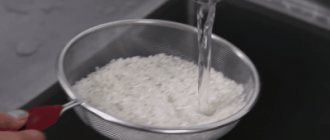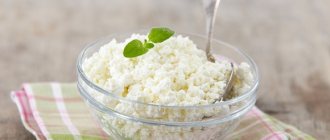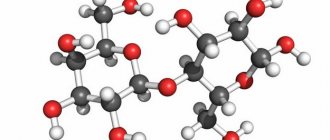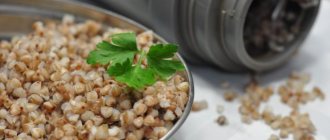- October 16, 2018
- Second courses
- Anna Kirnitskaya
For a variety of culinary recipes using buckwheat, it is necessary to determine the equivalent of cereals. If you have a special measuring cup, then everything is simple, but if you don’t have such a device on the farm, and you need to measure buckwheat now, a spoon or glass will do. You just have to figure out how much cereal will be in such a container. Many housewives are most often interested in the question of how much 100 grams of buckwheat is. Moreover, to complete the picture, we subtract the amount of dry cereal and boiled buckwheat.
Everyone knows that in order to cook buckwheat porridge, you take cereal and water in a ratio of 1:2. 10-12 minutes will be enough for cooking, you need to maintain low heat. After heat treatment, it immediately becomes noticeable that the volume of buckwheat has tripled. So, how much is 100 grams of boiled cereal? Surely most housewives have faced this question. Let’s dot the i’s and find out in more detail how much is 100 grams of buckwheat in tablespoons.
How much is the volume of one hundred grams of buckwheat?
When calculating this value, you should first understand the parameters of density and volumetric mass. Dry buckwheat will have a density of 800 g/l (grams per liter), which means that only 800 grams of product will fit into a liter jar (level with the top of the jar). In this case, the volumetric mass is 1.250 l/kg (liters per kilogram), that is, 1 kilogram of buckwheat will not fit in a liter jar, since it takes up more - 1.250 containers. Considering the features described above, remember that the answer to the question of how much 100 grams of buckwheat is is simple. One hundred grams of buckwheat occupies a volume of 125 milliliters.
How many grams of buckwheat in a teaspoon
Measuring cereal with a teaspoon is, of course, unusual, but just in case, below there is information for this case as well.
- About 8 grams of dry buckwheat with a small pile will fit in 1 teaspoon.
- Without a heap, 1 teaspoon will contain approximately 5 grams of “raw” buckwheat.
- 1 teaspoon will hold about 11 boiled buckwheat groats (with a heap)
- 1 teaspoon of boiled buckwheat without a heap is approximately 7 grams.
Table “How many grams of buckwheat in a spoon”
| Spoon type | Weight of raw (dry) buckwheat | Weight of boiled buckwheat |
| 1 tea without slide | 18 grams | 25 |
| 1 tea room with a slide | 25 grams | 30 g. |
| 1 dining room without slide | 5 grams | 7 years |
| 1 dining room with slide | 8 grams | 11 |
How much buckwheat is in 1 glass?
Now we have to figure out how many glasses 100 grams of buckwheat are. When understanding this issue, it is worth paying attention to the fact that there are two types of glasses: tea glasses and faceted glasses. Both are characterized by a volume of 250 ml, provided that the container is filled to the top.
The main difference between a faceted glass is a narrow strip located in the upper part, popularly called a rim or a belt. The volume of such a vessel along this very rim is 200 ml. It is important to know about this, since a cut glass is used in cooking more often than a tea glass.
Both glasses will contain 200 grams of cereal. This is provided that the container is filled to the top. Therefore, when figuring out how much 100 grams of buckwheat is, remember that in a glass half-filled there is exactly 100 grams of it.
Calorie content of boiled buckwheat and buckwheat porridge
How many grams does honey weigh in a tablespoon?
The nutritional value of porridge directly depends on the type of heat treatment and additional components that are added to enhance the taste. The calorie content of buckwheat porridge cooked in water is only 90 kcal, but if you add a little salt to the dish, the figure will increase by 15 units. When you add butter, the numbers will become even higher: with a spoon of vegetable - about 150 kcal, butter - 170 kcal.
The large interval is explained by the use of milk with different fat content. During a diet, it is best to cook porridge with a low-fat product. Boiled cereal is an ideal breakfast for people who have high blood sugar or problems with excess weight. You can read about the energy value of different cereals in our article.
The finished dish will not harm your figure and retains all its beneficial properties. The recipe for preparing cereal is simple: pour boiling water into a container (ratio 1×3), let it brew for about 12 hours under cling film or a terry towel, and in the morning it is ready for use.
How much boiled buckwheat can be made from dry cereal?
To cook buckwheat porridge, take 100 grams of buckwheat kernels and 200 ml of water. It is known that 200 ml of water is equal to 200 g. If the technology for preparing buckwheat porridge is followed, a small amount of water evaporates, and this percentage is about 10-15%. At the same time, the porridge is never fresh. Depending on the recipe, salt, sugar, milk, butter, etc. are added to the cereal. Therefore, depending on the preparation technology and the porridge recipe, from 100 grams of dry product the output is 270-300 grams of boiled porridge.
Here is the answer to this frequently asked question: 100 g of buckwheat - how much boiled cereal is this.
How many calories are in a spoonful of buckwheat?
Watch your figure, follow some kind of strict diet, constantly counting your daily calorie intake? In this case, you may be interested in the calorie content of one spoon of buckwheat, so that you ultimately consume as many calories as planned.
- To calculate, you first need to find out how many calories are in 100 grams of product.
- The calorie content of dry buckwheat per 100 grams is 308 kcal.
- The calorie content of boiled buckwheat per 100 grams is 92 kcal.
- It follows that 1 tablespoon of dry buckwheat contains 77 kcal. And 1 tablespoon of boiled buckwheat porridge is 27.6 kcal.
If you found this material useful, share the link on social networks. By the way, this site has many other useful articles: tips, various recipes, etc. We advise you to read it.
How much is 100 grams of boiled buckwheat porridge?
You should already understand that the mass of dry buckwheat groats exceeds the volumetric mass of water. Therefore, the volumetric mass of cooked porridge is higher than that of water and lower than that of dry cereal. This is approximately 1.08 ml/g (milliliters per gram). Taking this into account, 100 grams of boiled buckwheat:
- The volume occupied by the product is 108 milliliters, which is a little more than half a glass.
- This is a little more than 4 tablespoons. You can take heaping spoonfuls to get the required volume - 100 grams of boiled cereal.
Please note that the calorie content of buckwheat is 308 kcal, and the nutritional value of the product is:
- 12.6 g – proteins;
- 3.3 g – fats;
- 57.1 g – carbohydrates.
There is no need to talk much about the benefits of buckwheat; everyone already knows about its properties and qualities. Therefore, be sure to include this product in your weekly diet to feel better, more energetic, and healthier.
We tried to figure out some measurement methods to make it easier for you to understand how much 100 grams of buckwheat is. We hope this information will be useful to you and will definitely come in handy when preparing a variety of dishes from buckwheat - so popular, healthy, medicinal and dietary.
Caution in consuming buckwheat
The benefits of buckwheat can hardly be overestimated. However, everything needs moderation. If you are watching your weight or preparing a complex buckwheat dish for your family, then it is important to know how many grams are in a tablespoon of boiled buckwheat, what is the nutritional value and calorie content of the finished product.
Remember:
- Meals should be balanced and varied (even if you are on a diet). Buckwheat should be part of the diet, and not replace breakfast, lunch and dinner.
- People with gastrointestinal diseases can eat buckwheat, but in limited quantities. It can cause increased gas formation and bloating.
- Children should be given porridge with enough liquid, otherwise it may lead to constipation. Buckwheat porridge is administered to babies with caution to avoid allergies.
How to weigh dry buckwheat without scales in grams with spoons?
Before cooking porridge or preparing other dishes with buckwheat, it is important to accurately measure it according to the recipe, so calculations for the necessary measures have already been prepared below (the weight of buckwheat in a spoon has been rounded for convenience: 1 teaspoon of buckwheat = 3.5 grams, 1 tablespoon of buckwheat = 10 grams ):
- 200 grams of dry buckwheat = 20 level tablespoons.
- 150 grams of dry buckwheat = 15 tablespoons.
- 140 grams of dry buckwheat = 14 tablespoons.
- 130 grams of dry buckwheat = 13 level tablespoons.
- 120 grams of dry buckwheat = 12 tablespoons.
- 110 grams of dry buckwheat = 11 tablespoons.
- 100 grams of dry buckwheat = 10 level tablespoons.
- 90 grams of dry buckwheat = 9 tablespoons of buckwheat.
- 80 grams of dry buckwheat = 8 tablespoons.
- 70 grams of dry buckwheat = 7 tablespoons.
- 60 grams of dry buckwheat = 6 tablespoons.
- 50 grams of dry buckwheat = 5 tablespoons.
- 40 grams of dry buckwheat = 4 tablespoons of buckwheat.
- 30 grams of dry buckwheat = 3 tablespoons.
- 20 grams of dry buckwheat = 2 level tablespoons of buckwheat.
Useful articles on the topic: how many grams of water are in a faceted glass, how many grams of salt are in a tablespoon, how many grams of boiled buckwheat are in a tablespoon.
It is most convenient to weigh buckwheat with a tablespoon, while small quantities can also be weighed with a teaspoon, whichever is more convenient for you. If you still have questions about how much a spoonful of dry buckwheat weighs (a tablespoon or a teaspoon), write them in the comments below.
Inna Vilkova
Hi all! I am Inna, the author of articles on this blog. An enterprising housewife with more than 4 years of experience in a cleaning company. I will be happy to answer all questions on the topic of articles in the comments! Always ready to share my useful tips!
Save on social networks:
Calorie content of Buckwheat 100 g. Chemical composition and nutritional value.
Nutritional value and chemical composition of “Buckwheat 100 g”.
The table shows the nutritional content (calories, proteins, fats, carbohydrates, vitamins and minerals) per 100 grams of edible portion.
| Nutrient | Quantity | Norm** | % of the norm in 100 g | % of the norm in 100 kcal | 100% normal |
| Calorie content | 334 kcal | 1684 kcal | 19.8% | 5.9% | 504 g |
| Squirrels | 12 g | 76 g | 15.8% | 4.7% | 633 g |
| Fats | 2 g | 56 g | 3.6% | 1.1% | 2800 g |
| Carbohydrates | 67 g | 219 g | 30.6% | 9.2% | 327 g |
| Alimentary fiber | 11.3 g | 20 g | 56.5% | 16.9% | 177 g |
| Water | 14 g | 2273 g | 0.6% | 0.2% | 16236 g |
| Ash | 1.7 g | ~ | |||
| Vitamins | |||||
| Vitamin A, RE | 2 mcg | 900 mcg | 0.2% | 0.1% | 45000 g |
| beta carotene | 0.01 mg | 5 mg | 0.2% | 0.1% | 50000 g |
| Vitamin B1, thiamine | 0.2 mg | 1.5 mg | 13.3% | 4% | 750 g |
| Vitamin B2, riboflavin | 0.2 mg | 1.8 mg | 11.1% | 3.3% | 900 g |
| Vitamin B4, choline | 70 mg | 500 mg | 14% | 4.2% | 714 g |
| Vitamin B5, pantothenic | 1 mg | 5 mg | 20% | 6% | 500 g |
| Vitamin B6, pyridoxine | 0.3 mg | 2 mg | 15% | 4.5% | 667 g |
| Vitamin B9, folates | 32 mcg | 400 mcg | 8% | 2.4% | 1250 g |
| Vitamin E, alpha tocopherol, TE | 4 mg | 15 mg | 26.7% | 8% | 375 g |
| gamma tocopherol | 0.1 mg | ~ | |||
| delta tocopherol | 0.4 mg | ~ | |||
| Vitamin H, biotin | 10 mcg | 50 mcg | 20% | 6% | 500 g |
| Vitamin RR, NE | 4 mg | 20 mg | 20% | 6% | 500 g |
| Niacin | 4.2 mg | ~ | |||
| Betaine | 20 mg | ~ | |||
| Macronutrients | |||||
| Potassium, K | 380 mg | 2500 mg | 15.2% | 4.6% | 658 g |
| Calcium, Ca | 15 mg | 1000 mg | 1.5% | 0.4% | 6667 g |
| Silicon, Si | 100 mg | 30 mg | 333.3% | 99.8% | 30 g |
| Magnesium, Mg | 200 mg | 400 mg | 50% | 15% | 200 g |
| Sodium, Na | 3 mg | 1300 mg | 0.2% | 0.1% | 43333 g |
| Sera, S | 70 mg | 1000 mg | 7% | 2.1% | 1429 g |
| Phosphorus, P | 330 mg | 800 mg | 41.3% | 12.4% | 242 g |
| Chlorine, Cl | 80 mg | 2300 mg | 3.5% | 1% | 2875 g |
| Microelements | |||||
| Aluminium, Al | 40 mcg | ~ | |||
| Bor, B | 350 mcg | ~ | |||
| Iron, Fe | 7 mg | 18 mg | 38.9% | 11.6% | 257 g |
| Yod, I | 5 mcg | 150 mcg | 3.3% | 1% | 3000 g |
| Cobalt, Co | 3 mcg | 10 mcg | 30% | 9% | 333 g |
| Lithium, Li | 4 mcg | ~ | |||
| Manganese, Mn | 1.56 mg | 2 mg | 78% | 23.4% | 128 g |
| Copper, Cu | 640 mcg | 1000 mcg | 64% | 19.2% | 156 g |
| Molybdenum, Mo | 34.4 mcg | 70 mcg | 49.1% | 14.7% | 203 g |
| Nickel, Ni | 10.1 mcg | ~ | |||
| Tin, Sn | 30 mcg | ~ | |||
| Selenium, Se | 12 mcg | 55 mcg | 21.8% | 6.5% | 458 g |
| Titanium, Ti | 33 mcg | ~ | |||
| Fluorine, F | 30 mcg | 4000 mcg | 0.8% | 0.2% | 13333 g |
| Chromium, Cr | 5 mcg | 50 mcg | 10% | 3% | 1000 g |
| Zinc, Zn | 2.3 mg | 12 mg | 19.2% | 5.7% | 522 g |
| Digestible carbohydrates | |||||
| Starch and dextrins | 55.4 g | ~ | |||
| Mono- and disaccharides (sugars) | 1.4 g | max 100 g | |||
| Glucose (dextrose) | 0.43 g | ~ | |||
| Lactose | 0.03 g | ~ | |||
| Maltose | 0.17 g | ~ | |||
| Sucrose | 0.69 g | ~ | |||
| Fructose | 0.04 g | ~ | |||
| Essential amino acids | 3.65 g | ~ | |||
| Arginine* | 0.9 g | ~ | |||
| Valin | 0.6 g | ~ | |||
| Histidine* | 0.3 g | ~ | |||
| Isoleucine | 0.5 g | ~ | |||
| Leucine | 0.68 g | ~ | |||
| Lysine | 0.6 g | ~ | |||
| Methionine | 0.32 g | ~ | |||
| Methionine + Cysteine | 0.65 g | ~ | |||
| Threonine | 0.4 g | ~ | |||
| Tryptophan | 0.18 g | ~ | |||
| Phenylalanine | 0.59 g | ~ | |||
| Phenylalanine+Tyrosine | 1.02 g | ~ | |||
| Nonessential amino acids | |||||
| Alanin | 0.58 g | ~ | |||
| Aspartic acid | 1.1 g | ~ | |||
| Glycine | 0.72 g | ~ | |||
| Glutamic acid | 2.26 g | ~ | |||
| Proline | 0.5 g | ~ | |||
| Serin | 0.61 g | ~ | |||
| Tyrosine | 0.43 g | ~ | |||
| Cysteine | 0.33 g | ~ | |||
| Sterols (sterols) | |||||
| beta sitosterol | 50 mg | ~ | |||
| Saturated fatty acids | |||||
| Saturated fatty acids | 0.6 g | max 18.7 g | |||
| 14:0 Miristinovaya | 0.01 g | ~ | |||
| 16:0 Palmitinaya | 0.53 g | ~ | |||
| 18:0 Stearic | 0.04 g | ~ | |||
| 20:0 Arakhinovaya | 0.01 g | ~ | |||
| Monounsaturated fatty acids | 1.13 g | min 16.8 g | 6.7% | 2% | |
| 16:1 Palmitoleic | 0.02 g | ~ | |||
| 18:1 Oleic (omega-9) | 1.07 g | ~ | |||
| 20:1 Gadoleic (omega-9) | 0.02 g | ~ | |||
| Polyunsaturated fatty acids | 1.15 g | from 11.2 to 20.6 g | 10.3% | 3.1% | |
| 18:2 Linolevaya | 1.05 g | ~ | |||
| 18:3 Linolenic | 0.1 g | ~ | |||
| Omega-3 fatty acids | 0.1 g | from 0.9 to 3.7 g | 11.1% | 3.3% | |
| Omega-6 fatty acids | 1.05 g | from 4.7 to 16.8 g | 22.3% | 6.7% |
The energy value of 100 g of buckwheat is 334 kcal.
Primary Source: Created in the application by the user. Read more.
** This table shows the average levels of vitamins and minerals for an adult. If you want to know the norms taking into account your gender, age and other factors, then use the “My Healthy Diet” application.
